Progress report for FW15-041
Project Information
We will research using black soldier fly grubs as chicken feed to reduce financial and environmental costs associated with importing feed. We expect to reach 50 farmers, agricultural educators/technicians, and those interested in agriculture and eventually share the information regionally. According to an Agricultural Census conducted in 2007, Guam currently has 95 active farmers. O.M. Hale (1973) indicates that chicks fed a diet of black soldier fly larvae gained weight at the rate of 96% of that of chicks fed soybean meal plus fat, but they only consumed 93% as much feed. Guam has optimum conditions for raising black soldier fly larvae all year long. The fly is native to Guam making it easy to cultivate. Based on research conducted by Diambra-Odi (2014), Ussery (2011), St-Hilaire & Cranfill (2007), Hale (1973) and Sheppard (2007), we theorize that we can develop a feed using the black soldier fly. This project would be the first in this tropical region to conduct research of this kind.
In 2013, we began generating farm income, most of it from egg sales. Our highest operating cost is feed as 100% of poultry feed is imported. We raise 30 hens and will double their numbers by the end of 2014. Living on an island, the high cost of importation is transferred to the consumer. The average cost of feed is $24.00 per 50 pound bag. In addition to the high financial cost is the health cost, as all poultry feed are neither organic nor all-natural but rather contain antibiotics and genetically modified organisms.
We raise our chickens in a system that is as natural as we can make it. We expose them to sunlight and fresh air, allowing them to forage and roam freely for several hours a week. We buy one 50 pound bag of feed per week for $24.00 while making $70 per week in egg sales. Our feed costs consume 1/3 of our profit. With a renewable sustainable replacement, poultry farmers in Guam could reduce production costs and increase profit margins. Ambitious poultry farmers could formulate feed locally and reduce dependence on imported feed, thereby reducing our carbon footprint. The greatest benefit will be the ability to produce an egg 100% naturally and sustainably.
The black soldier fly, hermetia illucens, has been investigated for its bioconversion capabilities. The mature fly lays eggs. As larvae hatch they migrate to a food source and eat, extracting nutrients needed for growth and ejecting undigested components out of its body. Under ideal conditions, with enough food and heat, the larvae mature in ten days. The prepupal grubs leave the feeding medium looking for a place to burrow for the metamorphosis into the adult stage. This is when they “harvest” themselves and can be used to feed chickens. Grubs have consumed enough nutrients for their transition and are ripe for feeding to poultry. The colonies will be fed by food waste provided by two private businesses. Consistent food access is guaranteed.
This three-year project has four primary objectives: (1) to quantify the viability of black solider fly grub as a primary food source for egg laying livestock in remote tropical environments, (2) to reduce poultry farmers’ operating expenses, (3) to provide as an option, 100% locally sourced natural feed, and (4) to educate the agricultural community about economic potential of raising grubs as feed in a tropical environment.
The project requires six large plastic bins to house three colonies. Each colony requires two bins, one to house the colony and another stacked below to catch the liquid drainage. The liquid is a crop-feeding fertilizer comparable to compost tea. The grubs also produce a solid by-product that will be used as a soil amendment. Both will be weighed upon collection, documented, and used as fertilizer. This may prove to be an additional revenue stream or savings for poultry farmers but will require further research.
Modifications to the bins will allow the larvae to harvest themselves into separate containers. The project will require a temporary shed to house and protect the colonies from tropical weather, primarily rain and heat. Ussery (2011) states, “The high metabolic level of the grubs generates a good deal of heat, so any additional heat supplied by direct sunlight could be disastrous for the colonies.” Guam’s high temperatures reach between 86 degrees to 96 degrees. The colonies need protection. Rain and winds on Guam come from any direction and necessitate 360 degree shelter.
We will publish our research in a “Black Soldier Fly Larvae to Chicken Feed” guide in May 2016 prior to conducting two field visits; one in June 2016 and another in June 2017. We will conduct demonstrations in May 2016 and May 2017 at the Annual May Harvest hosted by the Guam Department of Agriculture. This event is attended by several hundred individuals. Visitors include farmers, agricultural technicians and educators, agriculture students, and people from the community interested in agriculture. We will also share information through annual reports submitted to Western SARE and in a comprehensive final report to be submitted upon completion of the project. Lastly, from June 2015 through June 2018 we will incorporate the use of social media in our outreach by documenting this project pictorially and through short video clips and sharing these media on Instagram, Twitter, Facebook, and through pages established by Farm to Table and others interested in agriculture.
-
Research the sustainability and economic viability of raising colonies of black solider fly grubs as feed to reduce egg production costs for poultry farmers. (June 2015 – June 2018)
-
Research and document a comparison study of egg-laying hens (growth and production potential): Group 1 raised using live black soldier fly grubs, Group 2 raised using dried black soldier fly grubs, and Group 3 raised using regular commercial feed. (June 2015 – June 2018) - Create a documented “feeding plan” that quantifies the amount of black soldier fly grubs needed for each hen in order to successfully produce quality eggs for sale. (December 2015 – June 2018)
- Encourage the adoption of black soldier fly grubs as an inexpensive sustainable all-natural feed source for poultry farmers in the region through educational outreach field days, demonstrations, and social media. (June 2015 – June 2018)
- Educate the agricultural community about best-practices regarding the adoption of black soldier fly grubs as an alternative sustainable all-natural feed source for poultry farmers in the region through field days, demonstrations, and chronicling progress on social media. (June 2016 – June 2018)
- Quantify the adoption impacts of this project via evaluation techniques such as before-and-after surveys and site visits. (June 2016 – June 2018)
We will accomplish these objectives by raising three colonies of black soldier fly larvae and three flocks of chickens. Each flock will have 14 chickens raised from chick stage. Each black soldier fly larvae colony will be raised in a 50 gallon plastic bin. The large bin size will accommodate large quantities of food waste to be deposited each day, thus encouraging prolific growth in the colony. Each bin will be placed on a table and connected to a “walk off” bin that the mature grubs will harvest themselves into. These grubs will then be collected, weighed, dried if appropriate, and mixed with appropriate amounts of calcium for each stage of growth (chick, pullet, layer) and fed to the chickens. Black soldier fly grubs are comprised of 40% protein and 30% fat. The colonies will be fed the same foods provided by waste products from our two partner restaurants.
Half of the harvested and weighed grubs will be fed live to one flock of chickens. The second half of harvested and weighed grubs will be dried in a dehydrator and fed to a second flock of chickens. The third flock of chickens will be fed imported store bought feed. Each bird will be tagged, in order to identify the bird, and weighed on a monthly basis. We will compare the growth and egg production of the three flocks. The liquid and solid by-products will be weighed and used as fertilizer.
Cooperators
Research
The project requires six large plastic bins to house three colonies. Each colony requires two bins, one to house the colony and another stacked below to catch the liquid drainage. The liquid is a crop-feeding fertilizer comparable to compost tea. The grubs also produce a solid by-product that will be used as a soil amendment. Both will be weighed upon collection, documented and used as fertilizer. This may prove to be an additional revenue stream or savings for poultry farmers but will require further research.
Modifications to the bins allow the grubs to harvest themselves into separate containers. The project uses a temporary shed to house and protect the colonies from tropical weather, primarily rain and heat. Ussery (2011) states, “The high metabolic level of the grubs generates a good deal of heat, so any additional heat supplied by direct sunlight could be disastrous for the colonies.” Guam’s high temperatures reach between 86 degrees to 96 degrees.
Five gallon buckets are left at two contributing restaurants, Mosa's Joint and Ture Cafe. Mosa's provides us food waste and Ture Cafe provides us with coffee grounds waste. Collecting food waste from the two restaurants provides an opportunity to use free food for the grubs and to reduce Guam's waste stream.
The food and coffee are dumped into the three large plastic bins which are then left to collect soldier fly larvae. The black soldier flies (BSF) are attracted to the odor of the food and coffee waste and lays eggs near the food. BSF do not lay eggs on food. When hatched, the larvae crawl into the food and begin consumption. When they are ready to be harvested, the larvae turn black and crawl out of the food. This is also the same time that they are ready to begin their metamorphosis into flies which compels their instinct to crawl out of the food and burrow into the ground. Incline ramps are built into the bins to provide the larvae with easy access out of the bins. The larvae will fall into a sealed container so that they may be harvested, weighed, and fed to chickens.
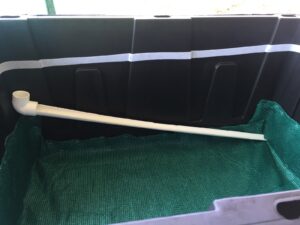
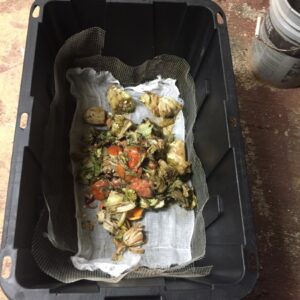
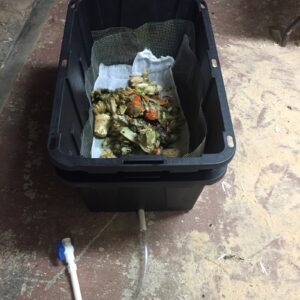
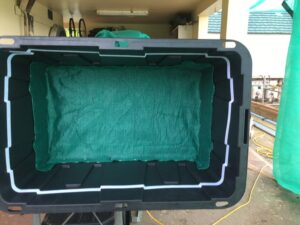
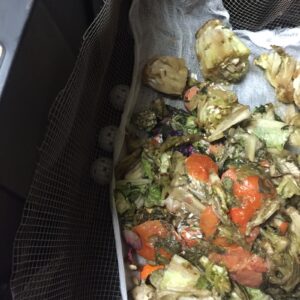
This three-year project has four primary objectives: (1) to quantify the viability of black solider fly grub as a primary food source for egg laying livestock in remote tropical environments, (2) to reduce poultry farmers’ operating expenses, (3) to provide as an option, 100% locally sourced natural feed, and (4) to educate the agricultural community about economic potential of raising grubs as feed in a tropical environment.
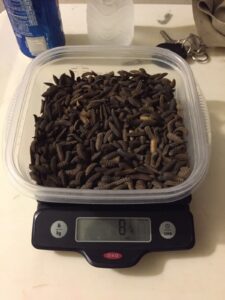
Research Outcomes
Education and Outreach
Participation Summary:
In 2016 the project coordinator organized two separate farm tours for interested farmers and members of the community. During the tour, participants visited the three separate chicken areas. Two of the chicken areas are older laying hens who had been part of the farm for the past 12 months. The third group of chickens are the experimental group, comprised of 20 birds who were still baby chicks and had not yet entered their laying phase. Participants were shown the shed that housed the project bins where the BSFL were being raised. The participants also had the opportunity to feed the larvae to the birds. Community members indicated that one of their primary interests in visiting the farm was to teach their children about raising hens.
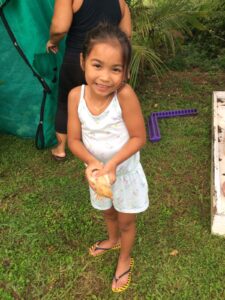
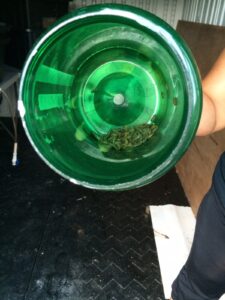
The project was unable to prepare for a demonstration for the Department of Agriculture ("DoA") May Harvest Festival. The DoA, along with all agencies under the Government of Guam, had been preoccupied with preparing the island to host 26 visiting island nations and territories, roughly 2500 delegates during the 2016 Festival of the Pacific Arts. The event occurs every four years and the island to host it changes each time. As 2016 was Guam's year, all Government Agencies were tasked with specific duties. According to agriculture representatives, the DoA "threw the event together at the last minute". The only exhibits at the event were from DoA subdivisions and one non-government group. We only found out about the event on the very day it occurred.
Our project did not have adequate notice to prepare for the event.


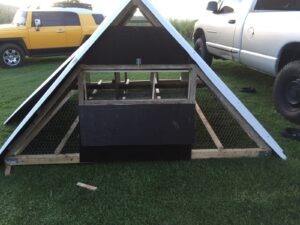



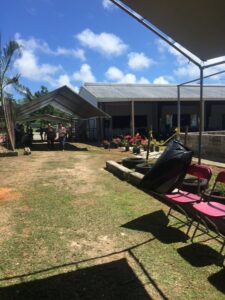
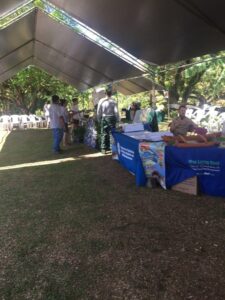
Education and Outreach Outcomes
Low cost of producing bsfl for feed
Chickens eagerly eating the larvae
Ease of growing and harvesting bsfl